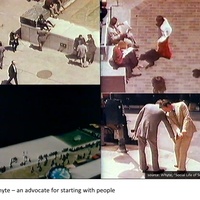"The Social Life of Small Urban Spaces", by William H. Whyte
Creada el 10 de Octubre de 2016 a las 18:54 por BirgiProyecto: Urban Games 2016
Tema: Recursos
Coordinadores:
abarca
dacama
Valoración general
0/5 (0 votaciones)Valoración de coordinadores
0/5 (0 votaciones)Descripción
EntradaBlog
Entrada de Blog
The Social Life of Small Urban Spaces: William H. Whyte from Nelly Oli on Vimeo.
Comentarios
He visto el vídeo y me he parado bastantes fragmentos, me ha parecido bastante singular como han hecho distintos estudios en la plaza del Seagram de como la gente actúa. También se puede observar como distintos acabados urbanísticos permiten o no la generación de actividades, como ejemplo de añadir elementos de una altura humana surgen relaciones humanas y integrando elemento muy distantes del suelo la gente ya no se sienta sino que estos se apoyan.
Accede o regístrate para comentar y puntuar la entrada.
